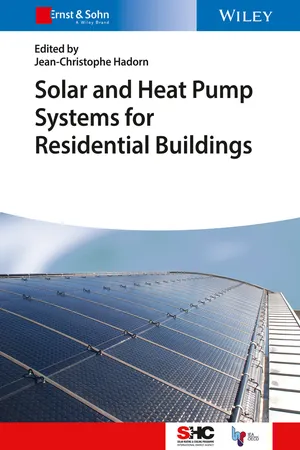
- English
- ePUB (mobile friendly)
- Available on iOS & Android
Solar and Heat Pump Systems for Residential Buildings
About this book
The combination of heat pumps and solar components is a recent development and has great potential for improving the energy efficiency of house and hot water heating systems. As a consequence, it can enhance the energy footprint of a building substantially.
This work compares different systems, analyses their performance and illustrates monitoring techniques. It helps the reader to design, simulate and assess solar and heat pump systems. Good examples of built systems are discussed in detail and advice is given on how to design the most efficient system.
This book is the first one about this combination of components and presents the state of the art of this technology. It is based on a joint research project of two programmes of the International Energy Agency: the Solar Heating and Cooling Programme (SHC) and the Heat Pump Programme. More than 50 experts from 13 countries have participated in this research.
Frequently asked questions
- Essential is ideal for learners and professionals who enjoy exploring a wide range of subjects. Access the Essential Library with 800,000+ trusted titles and best-sellers across business, personal growth, and the humanities. Includes unlimited reading time and Standard Read Aloud voice.
- Complete: Perfect for advanced learners and researchers needing full, unrestricted access. Unlock 1.4M+ books across hundreds of subjects, including academic and specialized titles. The Complete Plan also includes advanced features like Premium Read Aloud and Research Assistant.
Please note we cannot support devices running on iOS 13 and Android 7 or earlier. Learn more about using the app.
Information
1
Introduction
1.1 The Scope
1.2 Who Should Read This Book?
1.3 Why This Book?
1.4 What You Will Learn Reading This Book?
- – heating systems;
- – heat distribution by water-based systems (e.g., radiators and floor heating systems);
- – small-scale systems, one-family house to small dwellings (5–100 kW);
- – electrically driven heat pumps;
- – residential houses; and
- – new buildings and buildings to be renovated.
- You will understand that SHP systems are complex systems that need careful design and optimal integration.
- You will learn that good combinations of solar and heat pump can be achieved when the application is correctly done in adapted conditions. Examples are shown and discussed.
- You will discover which definitions for the seasonal performance factor (SPF) of an installation are recommended for a comparison of heating solutions, for the assessment of technologies, for an environmental analysis, or for some economical considerations.
- You will be able to classify all kinds of SHP systems in a new systematic way using the T44A38 “energy flow chart” diagram that you can use further to represent any kind of energy system.
- You will see the advantages of different combinations of SHP found on the market and be able to challenge the vendor on the system design and performance.
- You will learn that detailed simulation tools exist and a special framework to simulate SHP systems is available on the T44A38 web site.
- You will understand which energy flows you should monitor in a project or in the laboratory and what SPF you can reasonably expect.
- You will have the tools to assess the energy and economical benefits and other qualitative benefits that you can get out of a combination of SHP.
- You will have a tool to evaluate the cost of the delivered heat of an SHP and what CO2 reduction can be expected if you succeed to increase the SHP performance.
- – Part One: Theoretical considerations. Chapter 2 will tell you how the SHP systems found on the market in 2010–2012 can be classified i...
Table of contents
- Cover
- Related Titles
- Title Page
- Copyright
- About the Editor and the Supervisors
- List of Contributors
- IEA Solar Heating and Cooling Programme
- Forewords
- Acknowledgments
- Chapter 1: Introduction
- Part One: Theoretical Considerations
- Part Two: Practical Considerations
- Glossary
- Index
- EULA